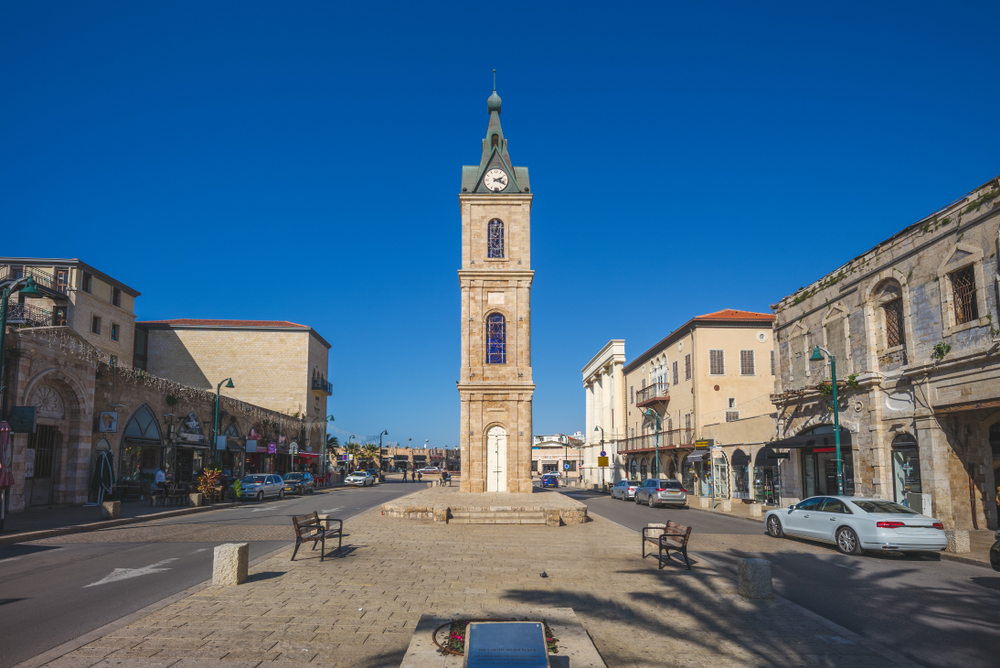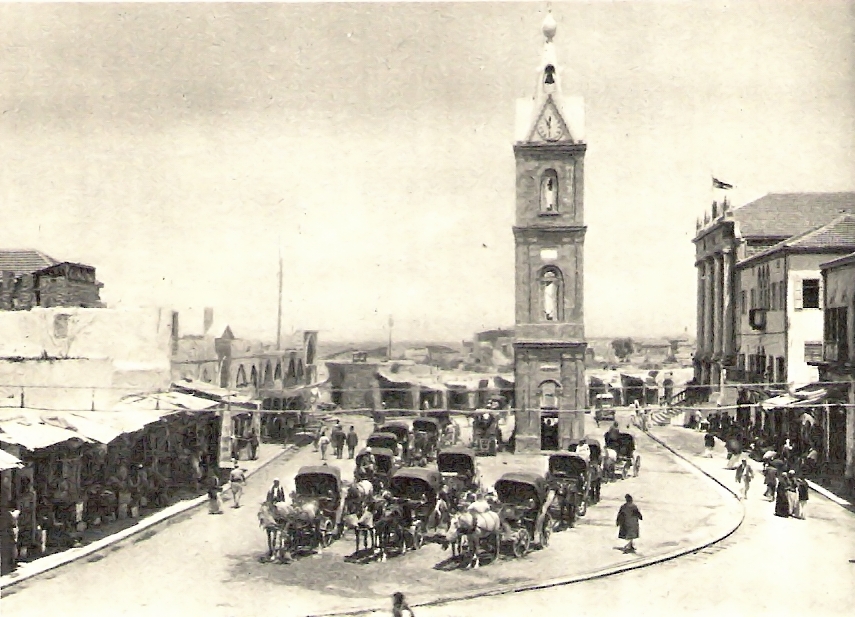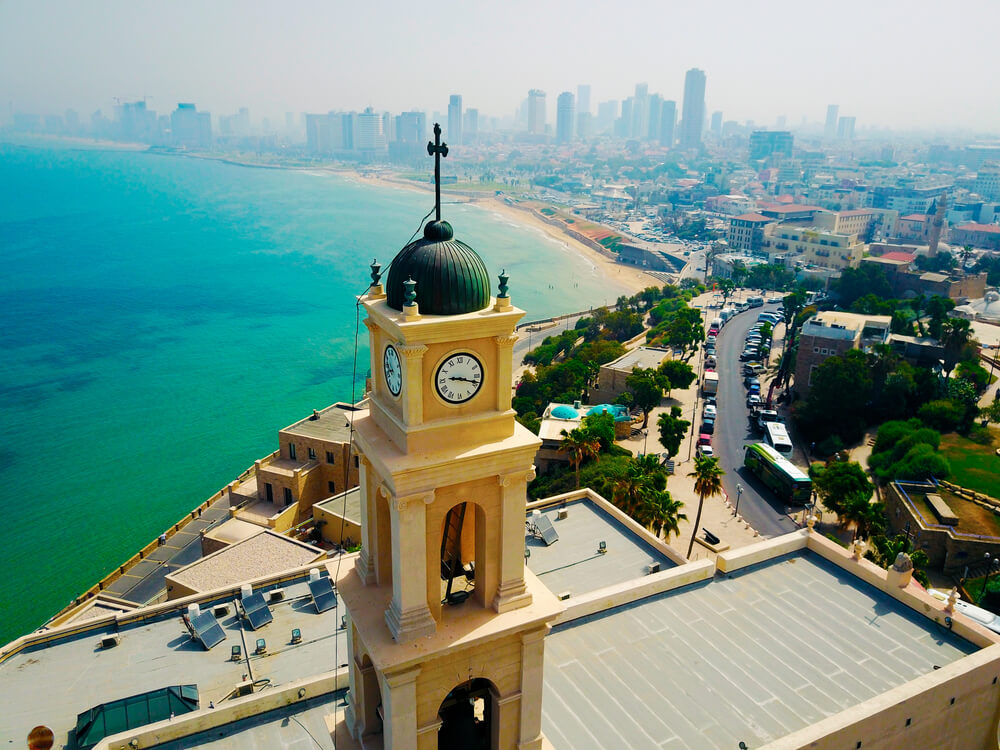Plan Your Visit
Israel’s most famous clock tower stands at the entrance to Jaffa, in Clock Square, at 14 Yefet Street. You can’t miss it as you enter this charming ancient port city. It looks like it belongs in Europe, but was built by the Turkish Ottomans. The Jaffa clock tower is the most popular meeting point in the city. Just tell your friends or tour guide to meet you at the clock tower and they will know exactly where you’ll be.
 The Jaffa Clock Tower
The Jaffa Clock Tower
Pro Tip: On the north face of the clock tower is a small door where you can enter the Jaffa Clock Tower Information Center. There is another visitors' center in Kedumim Square where you can also get information about Jaffa.
The first cornerstone for the clock tower was laid on September 1, 1900. In 1901 construction began on the clock tower in Jaffa and in 1903 it was completed. At the time it stood close to the Jaffa police station, detention center, Ottoman government offices, or Soraya. It was one of six clock towers built in what was then called Palestine, and ruled by the Ottomans. It was built to celebrate Sultan Abdul Hamid II's 25 years of rule in the Ottoman Empire. In total, the Turkish Ottomans constructed 100 clock towers throughout their empire to mark the silver anniversary of the Sultan’s reign.
Pro Tip: If you want to see the other clock towers you’ll find them at Acre above the Khan El-Umdan; Haifa in front of the El-Jarina Mosque; Safed, built above the Soraya Ottoman government complex, and in Nablus. The final clock tower was in Jerusalem but was demolished by the British in 1922.
 The Clock Tower in 1929
The Clock Tower in 1929
Today Jafa and Tel Aviv are a joint municipality but in 1901 Jaffa was a separate city and the Jewish, Christian, and Arab residents paid for its construction. It became extremely important in the 19th century as a focal point of the city where events and markets were held. Official buildings were built around it and a central parking area for horses and carriages was set up on present-day Beit Eshel Street. From here the Tel Aviv public transport departed taking people across the country. The clock tower has undergone several facelifts over the years, including those in 1965, 1966, and 2001.
Pro Tip: This is a great place to arrange to meet someone as you can’t miss it. It is also a popular starting point for tours.
The tower was built with limestone; it has four sides, and three floors (ground floor and two upper floors). It resembles a typical European church bell tower and has arched windows on the two upper levels and a similarly shaped doorway on the ground level.
In the window openings is stained glass depicting scenes from Jaffa’s history. The stained glass was designed by artist Arie Koren. At the top of the tower is a copper cover and hidden inside is a bell. The base of the tower measures 3.8 meters on each side, and the tower stands 27.8 meters tall from the ground to the top of the antenna.
The clock tower served an important purpose as most people didn’t have watches and needed a way to tell the time. Legend has it that a local businessman, Yossef Moyal, suggested the tower's construction because he was sick of people coming into his store to ask for the time. Nathaniel Markovich, a watchmaker with a store on Iskander Awad Street, was put in charge of the clock. And when the Turkish expelled the Jews during World War One, Markovich was given special permission to stay, so that he could continue operating the clock. The clocks that originally adorned the tower were made by a local Jewish watchmaker, Moritz Schoenberg.
 The Clock and the view
The Clock and the viewAt the time of construction, the tower had four clocks, one on each side of the tower. Two clocks showed the time in Europe and two showed the time in Israel. During the 1966 renovation, the ancient clocks were removed, and two new clocks were installed on the north and south sides of the tower. Another feature of the façade is a plaque commemorating the fallen soldiers from Israel’s War of Independence in 1948.
Notice the marble seal of the Ottoman Sultan that hangs about 12 meters above the sidewalk. It has the Sultan’s seal in relief and was featured on all the clock towers built in that year to honor the Ottoman ruler. Not long ago, the seal was restored. Before the restoration, it was virtually impossible to see the relief details as it was covered with smog and dirt. It got cleaned up, and it was also firmly attached to the tower as it had been dangerously close to falling off. At one time the tower had the Sultan’s seal on all four sides, but three haven’t survived and have been replaced with glass replicas.
Pro Tip: You can only see the original marble seal on the southern side.